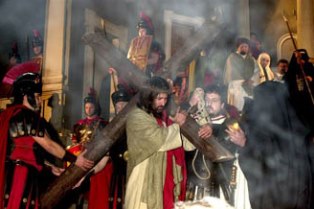
WTI Magazine #25 2014 Apr, 11
Author : folclore.it Translation by:
In folkloric and religious traditions are very common Italian commemorations of the Passion of Christ on the night of Good Friday.
Among these, the Turba in Cantiano has been certified by Europassion, European Association founded with the purpose of studying the phenomenon, among the most prestigious Sacred Representations of Europe. The procession itself has also been recognized by the High Patronage of the Pontificial Commission for the Cultural Heritage of the Church.
The Procession of Cantiano, inland from Pesaro, has its origins as far back as the thirteenth century, when the population used to rally on the streets asking for the intercession of the Holy God and of the Virgin Mary to put an end to a life of misery, at the mercy of constant wars and famines: a "turba" (crowd) of beat, scourged and penitent people, who invoked the grace of being able to live in better conditions.
The group of "Beaten from Cantiano" decided to imitate the example of Christ in the supreme moment of his passion, commemorating it during the Holy Week in the streets of the town.
Over the centuries, to the simple procession of the Flagellants was added the figure of Christ carrying the cross on his shoulder, and other figures of the Gospel, as well as dialogues taken from the Holy Scriptures, to carry out a careful representation imbued with religious and fraternal communion among the citizens who realized it.
Today, the Turba in Cantiano is a religious and theatrical event packed with special creative costumes and characters, made between the same stones where for centuries the history of the village has been narrated, blending dramatic reconstruction and city architecture.
The Turba begins at 5:30 in the morning through the streets of the town, where songs and prayers are sung along a path that touches the seven churches and chapels of the village.
At 15.30 there is the liturgical function in the Collegiate Church and the procession of the blessed Crucifix and Our Lady of Sorrows with the symbols of the Passion.
At 20 hymns, prayers and lauds are sung on the Collegiate, St. Nicholas and St. Augustine churchyards, while the Roman soldiers march on foot and on horseback, along the streets of the village lit only by the lights and accompanied by the dull sound of the drums.
From 20:45 in Piazza Luceoli and in the Parco delle Rimembranze are held the representation of Jude's conspiracy and betrayal, the last supper, the trial and sentencing of Jesus praying in the Garden of Olives, the capture of Christ.
On 22.30 from Piazza Luceoli starts the parade of the characters representing of the ascent to Calvary (on Colle Sant'Ubaldo), in the light of torches and braziers.
The last act is on 23 when finally the three empty crosses are erected, on the notes of the Te Deum, which leaves in the hearts of the people the hope for Resurrection.



